Patriot Javelin S4 Media Storage Server Review
By
Patriot Javelin S4 Configuration
As someone who has worked on large SANS frames let me tell you this box is right up there with features and is very impressive for a home unit. Management is very easy with two methods either the included software or through a web browser. The included software is very simple because it automatically locates the unit on your network and then allows you to configure the Javelin S4 with wizards or manual configuration. For more advance configuration options you can either start with the web interface (assuming you know the boxes IP Address) or connect to the web from the client software after it has found the box. The web interface is clean and based on AJAX to allow you full control over the system with real time updates. Finally If the included software or web interface do not give you enough control over the Javelin you can go to the extreme and download a plug-in from the Patriot support forums that allows you to root the box so you can directly mess around in the embedded BusyBox Unix OS. Just make sure you really know the BusyBox version of Unix and do not have any critical data on your array before you start playing around under the covers to minimize the risk of data loss.
Javelin S4 Quick Start:
The Javelin S4 is very simple to configure even if you only have the most basic understanding of computer networking. For the general user you simply fill the enclosure with one to four SATAII drives of your choosing and then plug the Javelin into power and Ethernet, preferably Gigabit Ethernet for maximum performance. Next insert the included CD and install the Javelin Dashboard software on your PC or Mac. The software will auto discover the Javelin S4 on your network and can even one click configure the device with default settings.
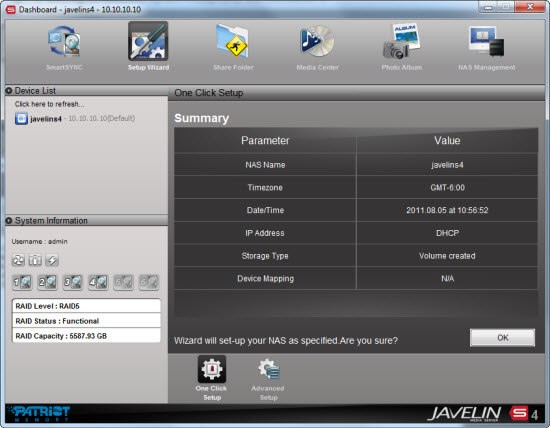
Once you have configured the Javelin S4 it will automatically map a network drive named “Public” to your computer. There are other default folders automatically created on the Javelin named Download, Music, Pictures, Upload, Videos, and WWW. Here is an example of a simple playlist I made from the music folder and the Dashboard software is streaming music to my PC.
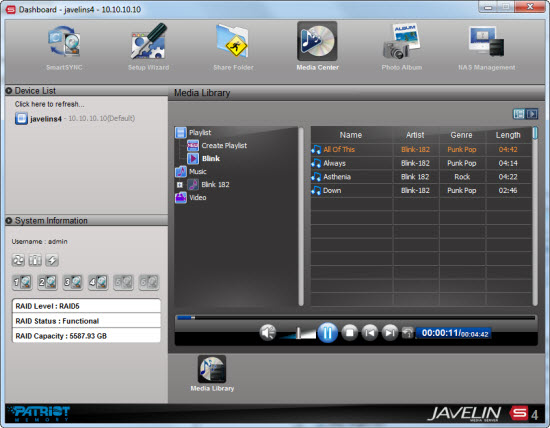
To move your data onto and off of the Javelin S4, Patriot also provides a wealth of options including CIFS for windows (map a drive), Bonjour for Mac, FTP, iSCSI Target, BitTorrent Client and Server, DLNA, UPnP, Squeezebox, and DDNS support for anywhere in the world connectivity. Many of these options are supported through the use of included plug-ins with the exception of squeezebox which you can download free from the Patriot Memory site. This means that if a new protocol is needed they can simply write another plug-in to support it. Great future proofing.
Something to point out is that these default folders are not just nice for organization, they have functions associated to them by the Patriot Javelin S4 OS. For instance the Javelin will take anything saved in the WWW folder and host it as a web server allowing you to host a web site and even supports PHP. Even nicer if your are a web dev, the Javelin has built in MySQL database so you can use the NAS as a great test server for your enterprise web sites.
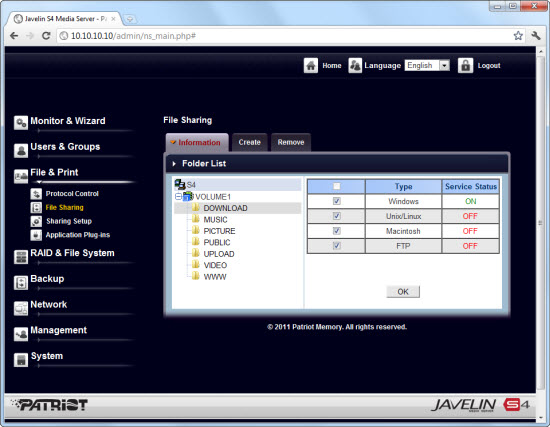
If you are an advanced user you can skip the software all together assuming you can find the IP Address the Javelin was assigned by your DHCP server. At that point you can enter a static IP and configure the rest of the parameters. For instance here is a shot of the web interface where I am configuring the four drives in a RAID set.
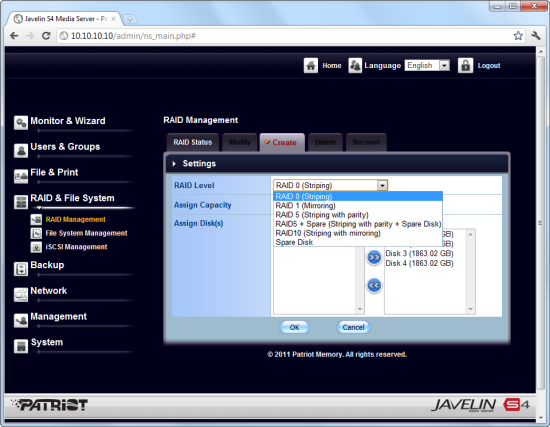
A great feature for a product at this price point is the option to use your RAID array as an iSCSI device. For those of you not familiar with iSCSI it is a protocol (SCSI) running over Ethernet that allows you to connect to a remote disk(s) as if it was connected directly to the SATA ports on your motherboard. This gives you block level access to your disk array and it simply appears as another drive letter. Why do you care for home users? Simple, there are several cloud backup solutions that have you pay one price to backup local hard drives and another price for both local and network attached such as a mapped drive. If you are mainly going to use the RAID array from a single computer, you can use iSCSI to make the entire array, up to 12TB, appear as a massive single, local hard drive and use the significantly less expensive cloud pricing. Only down side is then you would need to do a local windows based share if you wanted to give other devices on the network access to that drive. One strategy would be to split up the array and have an iSCSI portion for critical files you want to back up to the cloud and the rest of the space shared as a standard NAS share. The point is options, tons and tons of options.
If I had a complaint about the Javelin S4 it would be that the user manual is a bit confusing for the advanced features. For instance if you wanted to make this iSCSI drive you configure it under the iSCSI link in the web configuration window. However you need to think ahead and have a strategy when you first set up the RAID array. When you configure the raid array there is a box that says Maximum Capacity and defaults to the entire amount of disk space allocated. If you want a large iSCSI drive then you need to set this to a low value such as 1GB. This will leave the rest of the drive available for iSCSI. If you leave it at default such as 6705 GB here, then you cannot use that space for an iSCSI drive without deleting the whole array and starting over. Not a big deal if you know about it ahead of time, but they should explain this better in the manual.
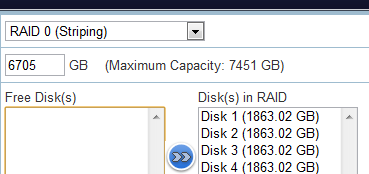
The rest of the advanced web administration is very intuitive and I did not have to even crack the manual to set up any of the other features. I could write 30 pages on setting up all the features so suffice it to say you should think about how you want to use this awesome piece of hardware before you just slap drives in and copy your critical data over. Do you want to do web dev, run iSCSI, use it as a bit torrent server or client, tie it into cloud back up? Think about how you want to use it before you configure it and you will get years of enjoyment out of such a powerful system.

Comments are closed.